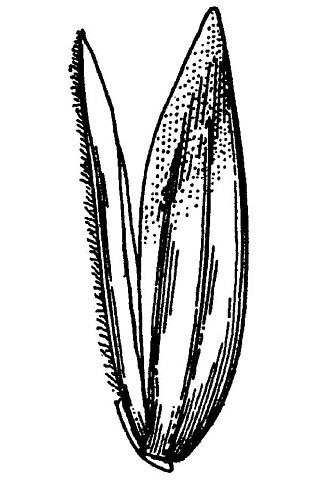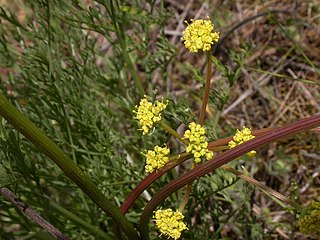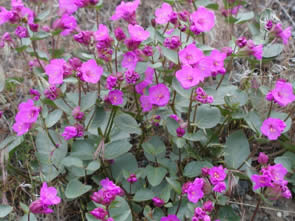
Platanthera yadonii, also known as Yadon's piperia or Yadon's rein orchid, is an endangered orchid endemic to a narrow range of coastal habitat in northern Monterey County, California. In 1998 this plant was designated as an endangered species by the United States government, the major threat to its survival being continuing land development from an expanding human population and associated habitat loss. One of the habitats of Yadon's piperia, the Del Monte Forest near Monterey, California, is the subject of a federal lawsuit, based upon endangerment of this organism along with several other endangered species.

Eriodictyon altissimum is a rare species of flowering plant in the borage family known by the common name Indian Knob mountainbalm. It is endemic to San Luis Obispo County, California, where it is known from only about six occurrences in the Irish Hills on the coast and nearby Indian Knob.

Hooveria purpurea is a species of flowering plant related to the agaves known by the common name purple amole. This species of soap plant is endemic to California, where it grows in the Santa Lucia Range, in the Central Coast region. There are two varieties of this plant, and both are believed to be quite rare. It is a federally listed threatened species.
Great Valley Grasslands State Park is a state park of California, United States, preserving a parcel of remnant native grassland in the San Joaquin Valley. Such a temperate grasslands, savannas, and shrublands biome was once widespread throughout the whole Central Valley. The 2,826-acre (1,144 ha) park was established in 1982. Largely undeveloped, it was formed by combining two former state park units: San Luis Island and Fremont Ford State Recreation Area. Its chief attractions for visitors are spring wildflowers, fishing, and wildlife watching.
Erysimum teretifolium is a species of Erysimum known by the common names Santa Cruz wallflower and Ben Lomond wallflower. It is a very rare plant endemic to Santa Cruz County, California, where it grows on inland sand spits, chaparral, and sandstone deposits in the southern Santa Cruz Mountains. It is a California state and federally listed endangered species.

Ambrosia pumila is a rare species of herbaceous perennial plant known by the common names San Diego ragweed and San Diego ambrosia. It is native to far southern California, Baja California, and Baja California Sur. It grows in floodplains and open grasslands in proximity to wetland areas.

Brodiaea pallida is a rare species of flowering plant in the cluster-lily genus known by the common name Chinese Camp brodiaea.

Lessingia germanorum is a rare species of flowering plant in the family Asteraceae known by the common name San Francisco lessingia. It is endemic to California, where it is known from four populations in the Presidio of San Francisco and one occurrence on San Bruno Mountain south of San Francisco. It is a state and federally listed endangered species. The already rare plant is endangered by many processes, including invasive species, development, sand mining, off-road vehicles and bulldozers, habitat fragmentation, trampling, and pollution, as well as stochastic events.
Plagiobothrys humistratus is a species of flowering plant in the borage family known by the common names dwarf popcornflower or low popcornflower. It is endemic to the Central Valley of California, where it grows in grassland habitats, including vernal pools and other wetland areas.

Plagiobothrys nothofulvus is a species of flowering plant in the family Boraginaceae known by the common names rusty popcornflower and foothill snowdrops. It is native to western North America from Washington, and California, to northern Mexico. It is a spring wildflower in grassy meadows, woodlands, coastal sage scrub, and wetland-riparian habitats.
Plagiobothrys parishii, known by the common name Parish's popcornflower, is an uncommon species of flowering plant in the borage family.

Poa napensis is a rare species of grass known by the common name Napa bluegrass. It is endemic to Napa County, California, where it is known from only two occurrences near Calistoga. It grows in moist, mineral-rich soil around hot springs. The rare grass only occurs on private, unprotected land and depends on water from the hot springs; changes to the local water regime or any other aspects of its specific habitat type would affect the plant. This grass was federally listed as an endangered species in 1997, along with another rare local hot spring endemic, the Calistoga popcornflower.
Pseudobahia bahiifolia is a rare species of flowering plant in the family Asteraceae known by the common name Hartweg's golden sunburst.

Pseudobahia peirsonii is a rare species of flowering plant in the family Asteraceae known by the common names San Joaquin adobe sunburst and Tulare pseudobahia. It is endemic to California, where it is known from a few mostly small occurrences along the southeastern side of the San Joaquin Valley where it rises into the Sierra Nevada foothills. It grows in grassland and oak woodland habitat. It prefers heavy adobe clay soils. The plant became a federally listed threatened of the United States in 1997.

Chionanthus pygmaeus is a rare species of flowering plant in the olive family known by the common name pygmy fringetree. It is endemic to Florida, where there are 46 known occurrences as of 2010. The plant is found in increasingly rare habitat in Central Florida that is being consumed for development, and some protected areas are not managed adequately. Most populations are small. It is a federally listed endangered species of the United States.

Conradina glabra is a rare species of shrub known by the common names Apalachicola rosemary or Apalachicola false rosemary. It is endemic to Liberty County, Florida, where it is known from about ten populations. It is found only in a small area and it is threatened by habitat destruction. It is a federally listed endangered species.

Lomatium cookii is a rare species of flowering plant in the carrot family known by the common names Cook's lomatium and agate desertparsley. It is endemic to Oregon in the United States, where it grows in only two valleys. It is a federally listed endangered species.

Mirabilis macfarlanei is a rare species of flowering plant in the four o'clock family known by the common name MacFarlane's four o'clock. It is native to Idaho and Oregon in the United States, where it is only known from three river canyons. It faces a number of threats and is federally listed as a threatened species of the United States.

Thlaspi californicum is a rare species of flowering plant in the family Brassicaceae known by the common name Kneeland Prairie penny-cress. It is endemic to California, where it is known from only one stretch of grassland in Humboldt County. It is threatened by development. It is a federally listed endangered species of the United States.

Acanthomintha ilicifolia, known by the common name San Diego thornmint, is a rare species of flowering plant in the mint family. It is native to Baja California and San Diego County, California, where it is a resident of the chaparral and coastal sage scrub plant communities and vernal pools.
















